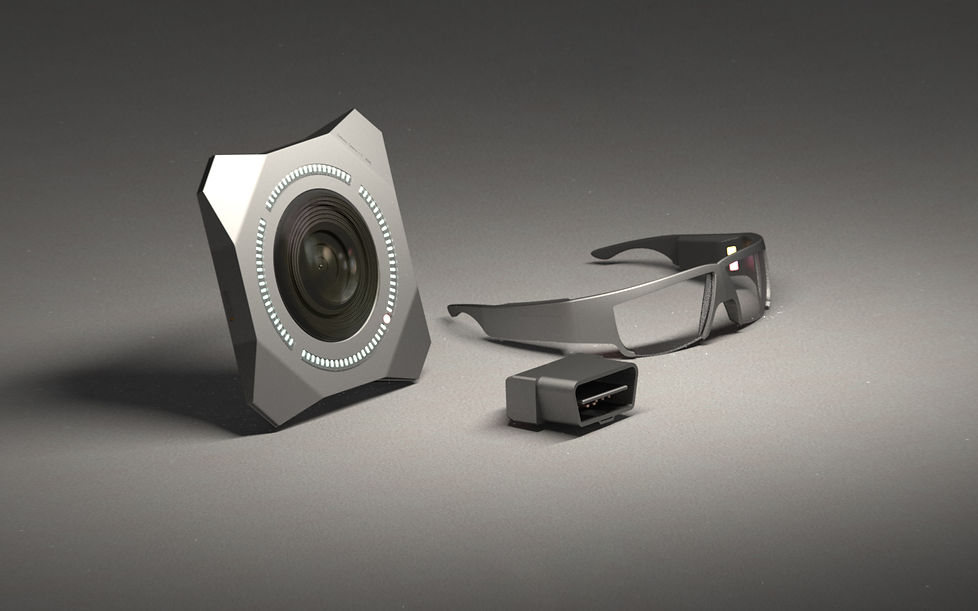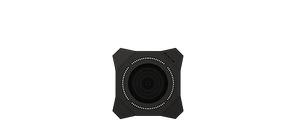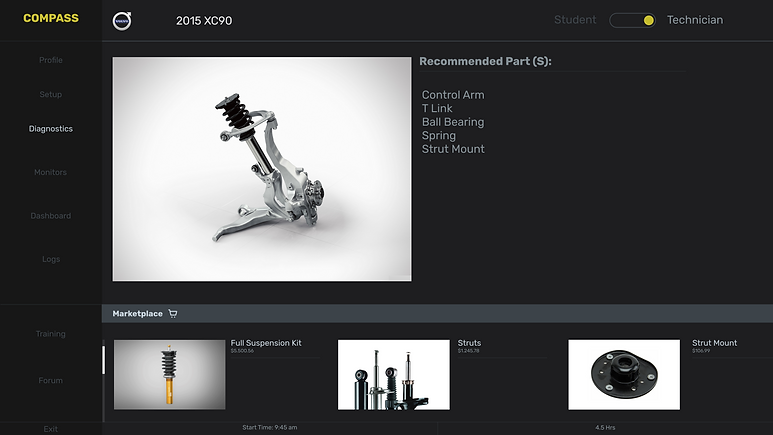
COMPASS
An interactive Augmented Reality ecosystem to train automotive technicians from multiple levels of experience how to work on modern day vehicles.
ID • UX / UI • Service • Concept Development • Research
Bridging
the Gap
BRIEF: Today's vehicles are advancing much faster than the driver's knowledge and the technicians that maintain them. Due to a steeper learning curve to fix these vehicles, auto technicians need more advanced tools to help them learn and repair them. How can we leverage Augmented Reality and use it as a learning tool that actively helps technicians perform a repair?
BRIEF: Today's vehicles are advancing much faster than the driver's knowledge and the technicians that maintain them. Due to a steeper learning curve to fix these vehicles, auto technicians need more advanced tools to help them learn and repair them. How can we leverage Augmented Reality and use it as a learning tool that actively helps technicians perform a repair?

Stage 1.
One on One with the User(s)
Several interviews were conducted with 2 groups, small mechanic shops and regional dealerships to discuss their current painpoints when dealing with newer vehicles. We wanted to have an understanding of problems where there would be overlap between the 2 different scales but also understand the nuances that are specific to their shops individually.
Several interviews were conducted with 2 groups, small mechanic shops and regional dealerships to discuss their current painpoints when dealing with newer vehicles. We wanted to have an understanding of problems where there would be overlap between the 2 different scales but also understand the nuances that are specific to their shops individually.
Chip G, Service Manager
"Often times we'll see a vehicle come back in because the original issue wasn't addressed. This is a hassle for us to try and rediagnose and the owner for spending more time here "

*Shelor Chrysler Dodge Employee
Alan C, Service Manager
"I've seen talented technicians who have been in the business for years who had to specialize only in older vehicles because the new ones aren't designed with mechanics outside of a dealership in mind. Especially when dealing with issues with the computers its as if you have to be a software engineer and a mechanic....."

*Shelor Chrysler Dodge Employee

Grayson, Apprentice
"A lot of my education was done online so i've been eager to get some hands on experience.
I've also noticed that a lot of the technicians in todays fields are younger. Many of the older technicians i've met tend to have administrative roles."
STAKEHOLDER MAP
Main Stakeholders
Supporting Actors

Synthesizing Research.
Diagnostics
Visualization
Time
Less Techs
01.
The computers don't always accurately give a read out of an error.
Or
Technician inaccurately identifies the issue by misreading the code
02.
Error codes are displayed in a way that isn's immediately understandable. Often new technicians will have to look up what they mean to continue the diagnosis.
03.
Often due to troubleshooting repairs can take longer than expected. Often the technician doesn't have a good gauge of how long these types of repairs will take. This leaves the vehicle owner in the dark and frustrated.
04.
The demand for automotive technicians is greater than ever as many of the current techs in the industry are facing retirement or leaving the field early due to the rapid changes in technology.
We analyzed the interview results for each group separately, then found similarities between the themes of the two groups, bringing us to these findings. From this synthesis, we found four major pain points.
From the information our team gathered, we created 2 journey maps that described a technician's typical experience regarding training and on the job repairs. We compared it to an ideal experience for COMPASS

“We're not mechanics; we're automotive technicians.You practically need to be an I.T. guy to work on new cars.”
The line between technical and digital has been blurred, its time for a technology that can better serve technicians and ease them into this new age of vehicles.
Independent shop owner
Design Goal.
How can we design a hands on experience while still keeping up with the new digital demands of the job?
Moving forward, these design goals will drive features and design decisions we create for our solution. Our solution should:
Adaptable Learning Tool
Having a tool that guides the users through the process makes the learning experience better.
Simplified Information
The design should be able to take a complex system, and data and make it simple for the user to understand.
Streamlined Process
Changing the users work routine to find the issue and tackle it faster.
Stage 2.
Visualising Reality


The range of OBD Diagnostic tools generally perform well for mechanics but, a majority of them still have pitfalls that limit the experience. The AR / VR products that exist from automakers usually only focus on the R&D and purchasing moments of a vehicle's lifespan. This leaves a considerable gap in the maintenance of the vehicle
Why Augmented
Reality?

Interaction / Involvement
AR provides real time learning in the environment which makes skills easier to grasp.
Clear Visualization
The overlay nature of the UI makes finding parts and diagnosis a more seamless process.
Mobile
AR allows you to see the diagnostics in any scenario / position which is important in a shop environment
When comparing the usability of a normal OBD2 scanner to that of system with AR, the benefits are outlined clearly.
See Service Blueprint + Task Flow
COMPASS
STANDARD OBDII SCANNER
-Flexible system that allows user to be in different parts of the vehicle at once with different views
-Customizable glasses interface
-Student portal for technical school integration
-Built in online forum
-Detailed videos / over laid info interface
-Over air updates
-Built in lighting system
-Playback of repairs
-Quick fault code read outs
-Sometimes have a bluetooth module
-Expensive ones have more in depth explanations
-May have to plug in for updates manually (paid for)
-Mostly Durable
Stage 3.
Form Language
AR GLASSES + CAMERA: The Camera and Glasses needed to fit in a shop environment with shop constraints. Durability, mobility, weight, and simplicity were all key features that these two components needed to embody.
Simple
Geometric
Tactile


Ideation
The form had to consider the shop environment as a form factor to make sure it worked well in that space.

*All devices are connected via bluetooth and video and data are uploaded to the cloud in real-time.


Camera comes with built in ring light to illuminate dark surfaces when the technician is working providing a better camera feed

Stage 4.
*Click screens to expand
Interface
Profile

The student portal offers students courses with highly detailed videos and infographics explaining the more complex parts of the vehicle.
Student / Technician Portal
Vehicle Dashboard
A digital dashboard mirrors the key information on the vehicle's dash when the technician is away from the vehicle
Mirror Dash

Device Setup

Once devices are paired they automatically sync with the cloud. All data is recorded and available for later viewing. (Eg. a repair, lesson)
IOT Devices






Training
The student portal offers students courses with highly detailed videos and infographics explaining the more complex parts of the vehicle.
Video Tutorials

Diagnostics

Fault code + fault code explanation video to help the technician understand exactly what issues may be involved with the diagnosis.
Detailed Explanations
Diagnostics
Parts / Marketplace
After a diagnosis parts are then recommended to the technician and links to purchase are provided below.

Forum

Connect
A built in forum so students and professionals can connect and answer questions.
Glasses View
Glasses View

Part pop up so the user knows what area they are examining
Phantom view of vehicle to direct technician of location of parts
Graphics are overlaid the technicians view that correspond to the repair they are making.

Testimonials
In the final stages of COMPASS, some of the initial user's interviewed were invited to take a look at rough prototypes and give their overall feedback / requests for improvements .
Chip G, Service Manager
"We are always looking to try new things in the shop and this certainly has the potential to be useful not just for the younger technicians but someone like me who has been at this for years"
"This reminds me a lot of some of the gaming VR I have at home and I could get lost in that for hours. If this is actually made I hope its as addictive."
Grayson
